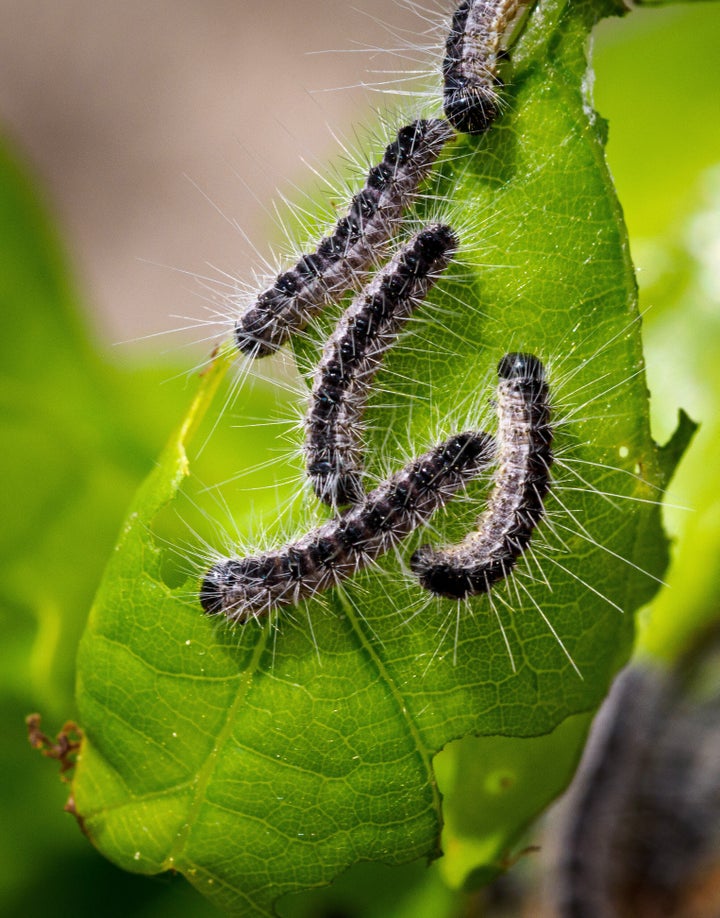
With summer coming up, it’s no wonder a whopping 42% of Brits are keen to get their gardens warm weather-ready as soon as they can.
But before you prep your patio and lavish love on your lawn, it might be worth keeping an eye out for a new backyard villain – the oak processionary moth caterpillar.
The Times recently reported that the caterpillar, which is “harmful to people and oak trees”, is slowly spreading from its London stronghold to the southeast of the UK, “leading experts to warn it will probably expand across most of the country.”
So we thought we’d find out how to spot the cruel critters, where they live, how they can affect you, and what to do if you come into contact with an oak processionary moth caterpillar yourself.
Here’s what we found:
How to spot a “toxic” hairy caterpillar
Forest Research say that though the invasive oak precessionary caterpillar looks similar to harmless native species – like the lackey moth and brown tail moth caterpillars – some of its behaviours and looks set it aside from the rest.
″(The) oak processionary moth feeds only on oak and produces large nests on oak trunks and large branches from May onwards. Hairy caterpillars which are not on oak or are not associated with a silk nest are almost certainly not (oak precessionary moths),” Forest Research say.
They add that you can spot one of the “toxic” moth “by their long white hairs on a dark, un-patterned body.”
Keep an eye out for 2-3cm-long caterpillars which have a grey body and a dark head with lengthy, white hairs, they say – especially those working in an “arrow-headed,” nose-to-tail formation on oak trees.
“They are not usually found on fences, walls and similar structures, such as garden furniture – these tend to be other, similar-looking caterpillars,” add Forest Research.
How can it hurt me?
The caterpillar causes damage via the shorter, toxic hairs on its body, apparently (fun).
Herts Wildlife Trust say that “Older caterpillars develop tiny hairs containing an urticating, or irritating, protein called thaumetopoein. Contact with the hairs can cause itching skin rashes... and eye irritations, sore throats, breathing difficulties and, rarely, allergic reactions in people and animals.”
“The risk of exposure to these hairs is highest in May and June,” they add (more wonderful news).
Of course, the mean moths don’t just affect our skin. The Royal Horticultural Society say that they defoliate oak trees, stripping them of their leaves.
So... where are these caterpillars hanging out?
While the Royal Horticultural Society says that “It appeared in South West London in 2005”, The Times reports they have since spread across London – and now to the southeast of England.
“One outbreak further afield a decade ago, at woods in Pangbourne, Berkshire, was considered so serious that the authorities used a helicopter to spray insecticide,” The Times says.
The species, which appears to be moving at a rate of about five miles a year, has been spotted moving further and further away from its London hub.
As The Times says, “A newly expanded “buffer zone” imposing restrictions on the movement of large oak trees now stretches from Colchester to Oxford and Eastbourne to Southampton.”
In fact, the Forestry Commission have created a map tracking the caterpillars’ sightings, which you can see here.
What do I do if I see one?
Firstly, do not touch the caterpillars or go near their nest.
The Royal Horticultural Society say that “The caterpillars should not be handled or approached.”
Instead, they say that “suspected cases should be reported via TreeAlert and where possible the landowner.”
And, they add, “Due to the irritant hairs control of this insect should only be carried out by professional contractors.”
Been stung already? Gov.uk says that “if you or someone in your care has a serious allergic reaction, get medical help. For less severe reactions, a pharmacist can provide advice on relief from skin or eye irritations.”
They also say that “if an animal in your care is seriously affected, get advice from a vet”, and warn to “Tell the medical person or vet you suspect it is due to OPM (oak processional moth) contact.“
Ah, the joys of nature...